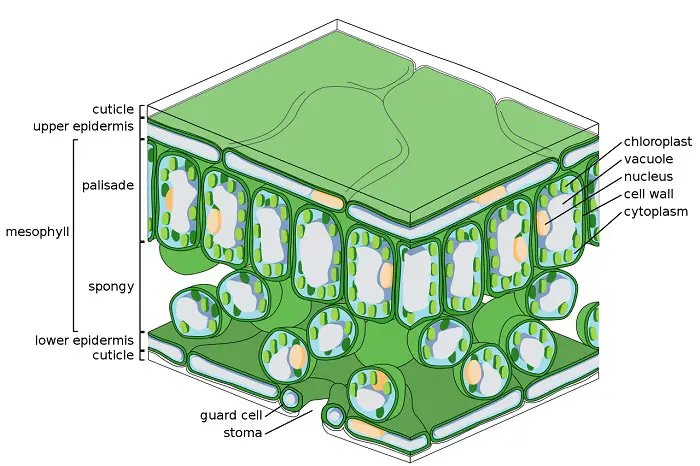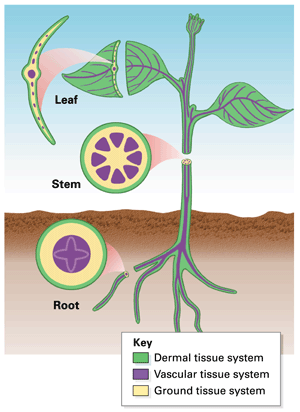Plant Tissue Systems
Like most animals, the organs of plants contain tissues with characteristic functions. For example, the xylem conveys water and dissolved minerals upward from the roots while the phloem transports sugars and other organic nutrients from leaves or storage tissues to other plant parts.

Three Types of Plant Tissue System
A tissue system is made of one or more tissues organized into a functional unit within a plant. Each plant organ is made up of three tissue systems–dermal, vascular, and ground–which are arranged differently in leaves, stems, and roots.
1. Dermal Tissue System
The dermal tissue system is the plant’s outer protective covering, like an animal’s skin. In nonwoody plants, the dermal tissue is made of a single layer of tightly packed cells called the epidermis. On leaves and most stems, the dermal cells secrete a waxy coating called the cuticle which helps prevent water loss.
2. Vascular Tissue System
The vascular tissue system is made up of the xylem and phloem tissues which provide support and long-distance transport between the root and shoot systems.
3. Ground Tissue System
Tissues that are neither dermal nor vascular make up the ground tissue system. The ground tissue system makes up most of the bulk of a young plant, filling the spaces between the epidermis and vascular tissue system. Ground tissue internal to the vascular tissue is called pith, while those external to the vascular tissue are called the cortex. The ground tissue system has many functions such as photosynthesis, storage, and support.
Monocot and Dicot Plant Tissue Systems: Differences and Similarities
The three tissue systems are also arranged differently between monocots and eudicots.
With regards to the roots of a eudicot, water and minerals absorbed from the soil must enter through the epidermis. In the center of the root, the vascular tissue systems form a vascular cylinder, with xylem cells radiating from the center like spokes of a wheel and phloem cells filling in the wedges between the spokes. The ground tissue system of the root, between the vascular cylinder and epidermis, is made up entirely of the cortex.
Cortex cells store food and take up minerals that enter the root. The innermost layer of the cortex is the endodermis, a cylinder one cell thick. The endodermis acts as a selective barrier that regulates the passage of substances between the cortex and the vascular tissue.
The monocot root also shares similarities with eudicots in an outer layer of the epidermis which surrounds a large cortex, with a vascular cylinder at the center. The difference is that the monocot vascular tissue is made of a central core of cells surrounded by a ring of xylem and phloem.
The stems of eudicots look quite different from monocots. Both stems have vascular tissue systems arranged in vascular bundles but in a monocot, the bundles are scattered whereas in a eudicot they are arranged in a ring that separates the ground tissue into cortex and pith regions.
The cortex fills the space between the vascular ring and epidermis while the pith fills the center of the stem and is often important in food storage. A monocot stem’s ground tissue is not separated into these regions due to the vascular bundles not forming a ring.
A typical eudicot leaf’s epidermis is interrupted by tiny pores called stomata (singular, stoma) which allow gas exchange (CO2 and O2) between the plant and the surrounding air. Also, most of the water vapor lost by a plant passes through the stomata. Each stoma is flanked by two guard cells which are specialized epidermal cells that regulate the opening and closing of the stoma.

The ground tissue of the leaf is called the mesophyll, found between the upper and lower epidermis. The mesophyll contains mainly cells specialized for photosynthesis. In a typical eudicot leaf, the cells in the lower area of a mesophyll are loosely arranged, with a labyrinth of air spaces through which CO2 and O2 circulate. The air spaces near the stoma become larger to facilitate gas exchange with the outside environment. In many monocots’ and other eudicots’ leaves, the mesophyll is arranged in distinct upper and lower areas.
The vascular tissue system of both monocots’ and eudicots’ leaves is made up of a network of veins, which is a vascular bundle composed of xylem and phloem tissues surrounded by a protective sheath of cells. The veins’ xylem and phloem are in close contact with the leaf’s photosynthetic tissues and ensure those tissues are supplied with water and mineral nutrients from the soil and that sugars made in the leaves can be transported throughout the plant. The vascular structure also acts as a support for the shape of the leaf.
As we hone in on the plant’s structure, we will be examining different cells that make up a plant and the function they perform.
Next topic: Plant Cell Types
Previous topic: Plant Organs
Return to the main article: Plant Form and Functions
Download Article in PDF Format
Test Yourself!
1. Practice Questions [PDF Download]
2. Answer Key [PDF Download]
Copyright Notice
All materials contained on this site are protected by the Republic of the Philippines copyright law and may not be reproduced, distributed, transmitted, displayed, published, or broadcast without the prior written permission of filipiknow.net or in the case of third party materials, the owner of that content. You may not alter or remove any trademark, copyright, or other notice from copies of the content. Be warned that we have already reported and helped terminate several websites and YouTube channels for blatantly stealing our content. If you wish to use filipiknow.net content for commercial purposes, such as for content syndication, etc., please contact us at legal(at)filipiknow(dot)net

